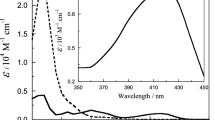Summary
The kinetics and the mechanism of the tiron-hydrogen peroxide reaction catalysed by cobalt ions are investigated. The oxidation of tiron results in a product of unknown structure, whose increase of concentration is utilized for photometric reaction rate measurements. On the conditions used (3.56 · 10−4 M tiron, 0.1 M hydrogen peroxide, pH 10.3) the reaction is of the first order with respect to tiron and catalyst concentration. The catalytic reaction, the rate constant of which was evaluated to be 4.7 · 104 l · Mol−1 · s−1, can be used for the determination of cobalt in the range from 0.6 to 10 ng/ml.
The results of the investigations on the oxidation rate of tiron and on the decomposition rate of hydrogen peroxide in dependence on pH indicate that the decomposition of hydrogen peroxide is a prerequisite for the oxidation of tiron. Whereas tiron itself shows a stabilizing effect on the oxidant, the complex formed in presence of cobalt ions catalyses the decomposition of hydrogen peroxide.
Zusammenfassung
Die Kinetik und der Mechanismus der von Kobaltionen katalysierten Tiron-Wasserstoffperoxid-Reaktion werden untersucht. Bei der Oxydation des Tirons bildet sich ein farbloses Produkt unbekannter Struktur, dessen Konzentrationszunahme zur photometrischen Messung der Reaktionsgeschwindigkeit dient. Unter den gewählten Bedingungen (3,56 · 10−4 M Tiron, 0,1 M Wasserstoffperoxid, pH 10,3) verläuft die Reaktion bezüglich der Tiron- und Katalysatorkonzentration nach der 1. Ordnung. Die katalytische Reaktion, deren Geschwindigkeitskonstante zu 4,7 · 104 l Mol−1 · s−1 ermittelt wurde, kann zur Kobaltbestimmung im Bereich von 0,6–10 ng/ml verwendet werden.
Die Ergebnisse der Untersuchungen über die Oxydationsgeschwindigkeit des Tirons und über die Zersetzungsgeschwindigkeit des Wasserstoffperoxids in Abhängigkeit vom pH-Wert deuten darauf hin, daß die Zersetzung des Wasserstoffperoxids Voraussetzung für die Oxydation des Tirons ist. Während Tiron selbst eine stabilisierende Wirkung auf das Oxydationsmittel ausübt, katalysiert ein in Gegenwart von Kobaltionen entstehender Komplex dessen Zersetzung.
Similar content being viewed by others
Literatur
Bognár, J.: Mikrochim. Acta 1961, 901.
- Mikrochim. Acta 1963, 801; vgl. diese Z. 207, 371 (1965).
, u. O. Jellinek: Acta Chim. Acad. Sci. Hung. 29, 21 (1961).
- - Mikrochim. Acta 1962, 746; vgl. diese Z. 197, 376 (1963).
Jacimirskij, K. B.: Kinetičeskie metody analiza, Goschimizdat, Moskva 1963.
Laszlovszky, J.: Mikrochim. Acta 1960, 72; vgl. diese Z. 177, 290 (1960).
: Acta Chim. Acad. Sci. Hung. 26, 133 (1961).
- Mikrochim. Acta 1961, 289; vgl. diese Z. 187, 46 (1962).
- Mikrochim. Acta 1962, 441; vgl. diese Z. 194, 289 (1963).
: Acta Chim. Acad. Sci. Hung. 41, 133 (1964).
Author information
Authors and Affiliations
Additional information
Frau M. Borrmann gilt unser Dank für experimentelle Mitarbeit.
Rights and permissions
About this article
Cite this article
Kucharkowski, R., Döge, H.G. Zur Oxydation von Tiron mit Wasserstoffperoxid in Gegenwart von Kobalt. Z. Anal. Chem. 238, 241–251 (1968). https://doi.org/10.1007/BF00499724
Received:
Issue Date:
DOI: https://doi.org/10.1007/BF00499724



